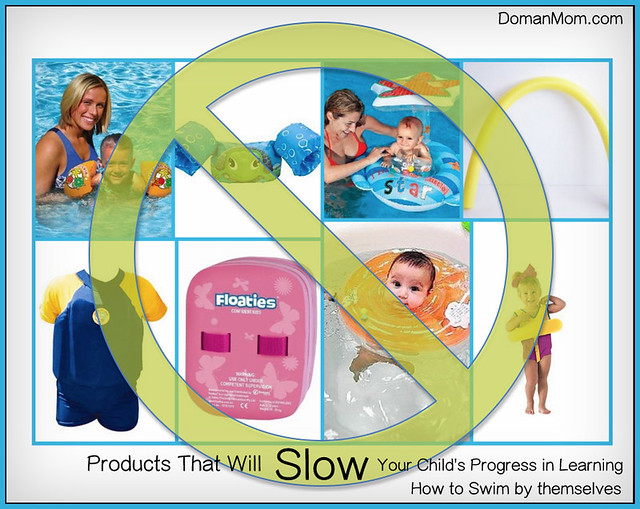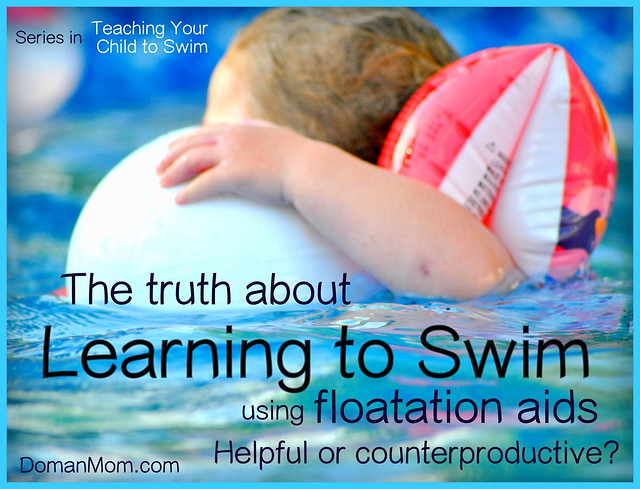Are floatation aids helpful or counterproductive in teaching your child how to swim?
Arm band "floaties", bodysuits with built-in floatation pads or rings around the chest, waist, or arms, jackets, straps, noodles, seats, pads. The products abound.
All of these items artificially keep your child afloat in the water and many times tout names such as "swim trainer", "learn to swim", "swim school", "swim instructor", and more.
But do these products really help teach your child how to swim?
Doman says no. Why?
"They prevent the brain from receiving real information about the water environment. Floatation devices create an artificial environment. The baby's brain only receives information about breathing, balance, coordination, tactility, etc., based upon the influence of a floatation device."
Learning any physical skill is simply the process of your brain receiving sensory input from the environment. Your brain then processes that sensory input and sends signals to different parts of your body to adjust, coordinate, move, and compensate in order to achieve the desired action or movement. Eventually, with enough sensory input and practice, your brain will have mastered how to maneuver in the desired way in that specific environment.Floatation devices create a fake environment. With the floatation aid:
- The child is held up by the device (obviously, because that is its purpose) so their brain does not receive the information about how to hold themselves up in the water (swim by themselves)
- Since the child is being held up by the aid, all the child needs to do in order to move about in the water ("swim") is kick or wiggle their legs in any random motion. The arms are not even necessary with the floatation aid (and they are very necessary in actual swimming), and the leg movements they learn to use are random, sporadic, and will be completely ineffective in actual swimming. They learn the wrong motions and build non-functional habits.
This is not only a waste of time since the time in the water with floatation aids didn't actually teach your child anything about swimming, but it is actually disadvantageous because your child has built wrong habits, and it is much harder to break a bad habit than it is to just start from scratch and learn something new.
And who wants to do that?
 Images via products on Amazon.com
Images via products on Amazon.comDon't buy into the hype about "learn to swim" aids.
Do you know what do you need to teach your child how to swim?
A safe, clean body of water, a loving parent, and a little insight on some simple techniques. And, well, a child.
End of list.
Please note: this post is about swim lessons and teaching your child how to swim while in a safe environment, not about safety devices and their appropriate use. You and your child should always wear a coast-guard approved life jacket when boating or participating in similar water sports and activities, no matter how well any one of you can swim.


2013/06/29 at 7:19 am
ReplyDeleteI agree that using flotation devices doesn’t help children learn to swim, but they do help with water confidence. I have a set of 6 armband disks that we use with my 3 year old beginner swimmer. After we’ve been in the water a while, I put them on for 5-10 minutes to let him have a sense of independence, since with them he can doggy paddle the width of the pool. This is the ‘fun bit’ at the end of the lesson. As his ability grows, I’ll cut down on this time and remove a pair of bands until we forget about them all together, but for now they help.
2013/06/29 at 8:06 am
DeleteThat’s a great tip! It seems like a balanced and helpful technique to me. Thanks for sharing.
2014/06/17 at 4:30 pm
ReplyDeleteAs a swim instructor for over twenty years I applaud you for this article. You are offering the best advice for parents who want their children to grow up to be strong swimmers. Floatation devices offer a quick fix for parents of children who can’t swim yet but they definitely cause almost permanent damage in my opinion depending on the amount of time a child has spent in one. I can tell within a moment of holding a child in the water if they’ve spent any time in a flotation device and those are the children who end up needing MUCH more individualized attention to break and undo bad habits. Puddle Jumpers and arm floaties etc end up costing the parent more in the long run and I’m not sure, only time will tell, if this generation of puddle jumpers will end up being weaker swimmers as adults.
I love this article and it aligns with my philosophy about my child learning to move in general. My question, though..... we have plans to go to a lake and go boating towards the end of the summer. I bought a seated flotation device for when we go, since we will drop anchor and swim in very deep water. I don't plan to keep my son in it the entire time, and we're going to do 3 days a week of swim lessons until that time, but my plan was to use it more for safety than for making my life easier.
ReplyDeleteWill this un-do our lessons?